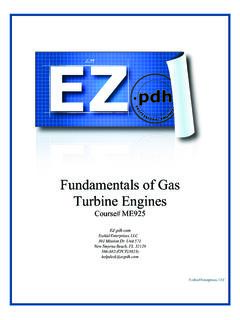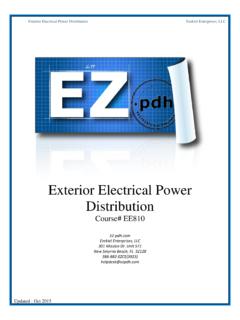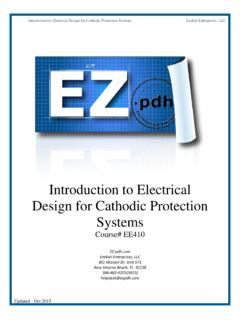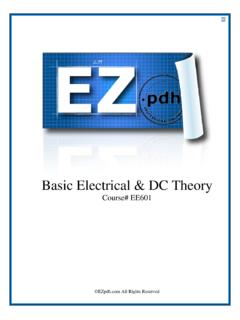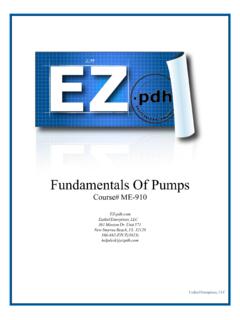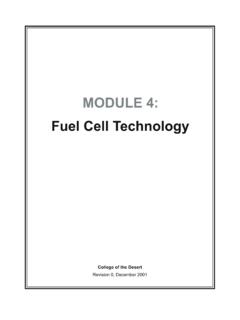Transcription of Diesel Engine Fundamentals
1 Diesel Engine Fundamentals Course# ME406 All Rights Reserved Department of EnergyFundamentals HandbookMECHANICAL SCIENCEM odule 1 Diesel Engine FundamentalsDiesel Engine FundamentalsDOE-HDBK-1018/1-93 TABLE OF CONTENTSTABLE OF CONTENTSLIST OF iiLIST OF viDIESEL 2 Diesel 2 Major Components of a Diesel 3 Diesel Engine Support 12 Exhaust 16 Operational 20 Fundamentals OF THE Diesel 21 The Basic Diesel 21 The Four-Stoke 22 The Two-Stroke 28 Diesel Engine SPEED, FUEL CONTROLS,AND 30 Engine 30 Fuel 34 Operation of a 34 Starting 38 Engine 40 Rev. 0ME-01 Page iLIST OF FIGURESDOE-HDBK-1018/1-93 Diesel Engine FundamentalsLIST OF FIGURESF igure 1 Example of a Large Skid-Mounted, Diesel -Driven 2 Figure 2 Cutaway of a Four-Stroke Supercharged Diesel Engine .
2 4 Figure 3 Cross Section of a V-type Four Stroke Diesel 5 Figure 4 The Cylinder 6 Figure 5 Diesel Engine Wet Cylinder 7 Figure 6 Piston and Piston 7 Figure 7 Diesel Engine Crankshaft and 9 Figure 8 Diesel Engine 10 Figure 9 Diesel Engine Camshaft and Drive 10 Figure 10 Diesel Engine Valve 11 Figure 11 Diesel Engine cooling 12 Figure 12 Diesel Engine Internal Lubrication 13 Figure 13 Diesel Engine Fuel 14 Figure 14 Oil Bath Air 15 Figure 15 Compression 18 Figure 16 Scavenging and 22 Figure 17 23 Figure 18 Fuel 24 Figure 19 24 Figure 20 25 Figure 21 2-Stroke 26ME-01 Rev. 0 Page iiDiesel Engine FundamentalsDOE-HDBK-1018/1-93 LIST OF FIGURESLIST OF FIGURES (Cont.)Figure 22 2-Stroke 26 Figure 23 2-Stroke 27 Figure 24 2-Stroke Fuel 27 Figure 25 2-Stroke 27 Figure 26 Fuel Injector 31 Figure 27 Fuel Injector 33 Figure 28 Simplified Mechanical-Hydraulic 35 Figure 29 Cutaway of a Woodward 36 Rev.
3 0ME-01 Page iiiLIST OF TABLESDOE-HDBK-1018/1-93 Diesel Engine FundamentalsLIST OF TABLES NONEME-01 Rev. 0 Page ivDiesel Engine FundamentalsDOE-HDBK-1018/1-93 REFERENCESREFERENCES Benson & Whitehouse, Internal Combustion Engines, Pergamon. Cheremisinoff, N. P., Fluid Flow, Pumps, Pipes and Channels, Ann Arbor Science. Scheel, Gas and Air Compression Machinery, McGraw/Hill. Skrotzki and Vopat, Steam and Gas Turbines, McGraw/Hill. Stinson, Karl W., Diesel Engineering Handbook, Diesel Publications 0ME-01 Page vOBJECTIVESDOE-HDBK-1018/1-93 Diesel Engine FundamentalsTERMINAL references, DESCRIBE the components and theory of operation for a the following Diesel Engine a drawing of a Diesel Engine , IDENTIFY the ports or valve(s) ports or valve(s) how a Diesel Engine converts the chemical energy stored in the Diesel fuel intomechanical how the ignition process occurs in a Diesel the operation of a 4-cycle Diesel Engine to include when the following eventsoccur during a 0 Page viDiesel Engine FundamentalsDOE-HDBK-1018/1-93 OBJECTIVESENABLING OBJECTIVES (Cont.)
4 The operation of a 2-cycle Diesel Engine , including when the following eventsoccur during a how the mechanical-hydraulic governor on a Diesel Engine controls five protective alarms usually found on mid-sized and larger Diesel 0ME-01 Page viiOBJECTIVESDOE-HDBK-1018/1-93 Diesel Engine FundamentalsIntentionally Left Blank ME-01 Rev. 0 Page viiiDiesel Engine FundamentalsDOE-HDBK-1018/1-93 Diesel ENGINESDIESEL ENGINESOne of the most common prime movers is the Diesel Engine . Before gaining anunderstanding of how the Engine operates a basic understanding of the Engine 'scomponents must be gained. This chapter reviews the major components of ageneric Diesel the following Diesel Engine chamberEO a drawing of a Diesel Engine , IDENTIFY the ports or valve(s) ports or valve(s) injectorIntroductionMost DOE facilities require some type of prime mover to supply mechanical power for pumping,electrical power generation, operation of heavy equipment, and to act as a backup electricalgenerator for emergency use during the loss of the normal power source.
5 Although several typesof prime movers are available (gasoline engines, steam and gas turbines), the Diesel Engine isthe most commonly used. Diesel engines provide a self-reliant energy source that is availablein sizes from a few horsepower to 10,000 hp. Figure 1 provides an illustration of a commonskid-mounted, Diesel -driven generator. Relatively speaking, Diesel engines are small,inexpensive, powerful, fuel efficient, and extremely reliable if maintained of the widespread use of Diesel engines at DOE facilities, a basic understanding of theoperation of a Diesel Engine will help ensure they are operated and maintained properly. Due tothe large variety of sizes, brands, and types of engines in service, this module is intended toprovide the Fundamentals and theory of operation of a Diesel Engine .
6 Specific information ona particular Engine should be obtained from the vendor's manual. Rev. 0ME-01 Page 1 Diesel ENGINESDOE-HDBK-1018/1-93 Diesel Engine FundamentalsHistoryFigure 1 Example of a Large Skid-Mounted, Diesel -Driven GeneratorThe modern Diesel Engine came about as the result of the internal combustion principles firstproposed by Sadi Carnot in the early 19th century. Dr. Rudolf Diesel applied Sadi Carnot'sprinciples into a patented cycle or method of combustion that has become known as the " Diesel "cycle. His patented Engine operated when the heat generated during the compression of the airfuel charge caused ignition of the mixture, which then expanded at a constant pressure duringthe full power stroke of the Diesel 's first Engine ran on coal dust and used a compression pressure of 1500 psi toincrease its theoretical efficiency.
7 Also, his first Engine did not have provisions for any type ofcooling system. Consequently, between the extreme pressure and the lack of cooling , the engineexploded and almost killed its inventor. After recovering from his injuries, Diesel tried againusing oil as the fuel, adding a cooling water jacket around the cylinder, and lowering thecompression pressure to approximately 550 psi. This combination eventually proved rights to the Engine were sold to Adolphus Bush, who built the first Diesel enginesfor commercial use, installing them in his St. Louis brewery to drive various EnginesA Diesel Engine is similar to the gasoline Engine used in most cars. Both engines are internalcombustion engines, meaning they burn the fuel-air mixture within the cylinders.
8 Both arereciprocating engines, being driven by pistons moving laterally in two directions. The majorityof their parts are similar. Although a Diesel Engine and gasoline Engine operate with similarcomponents, a Diesel Engine , when compared to a gasoline Engine of equal horsepower, isheavier due to stronger, heavier materials used to withstand the greater dynamic forces from thehigher combustion pressures present in the Diesel 0 Page 2 Diesel Engine FundamentalsDOE-HDBK-1018/1-93 Diesel ENGINESThe greater combustion pressure is the result of the higher compression ratio used by dieselengines. The compression ratio is a measure of how much the Engine compresses the gasses inthe Engine 's cylinder. In a gasoline Engine the compression ratio (which controls thecompression temperature) is limited by the air-fuel mixture entering the cylinders.
9 The lowerignition temperature of gasoline will cause it to ignite (burn) at a compression ratio of less than10:1. The average car has a 7:1 compression ratio. In a Diesel Engine , compression ratiosranging from 14:1 to as high as 24:1 are commonly used. The higher compression ratios arepossible because only air is compressed, and then the fuel is injected. This is one of the factorsthat allows the Diesel Engine to be so efficient. Compression ratio will be discussed in greaterdetail later in this difference between a gasoline Engine and a Diesel Engine is the manner in which enginespeed is controlled. In any Engine , speed (or power) is a direct function of the amount of fuelburned in the cylinders. Gasoline engines are self-speed-limiting, due to the method the engineuses to control the amount of air entering the Engine .
10 Engine speed is indirectly controlled bythe butterfly valve in the carburetor. The butterfly valve in a carburetor limits the amount ofair entering the Engine . In a carburetor, the rate of air flow dictates the amount of gasoline thatwill be mixed with the air. Limiting the amount of air entering the Engine limits the amount offuel entering the Engine , and, therefore, limits the speed of the Engine . By limiting the amountof air entering the Engine , adding more fuel does not increase Engine speed beyond the pointwhere the fuel burns 100% of the available air (oxygen). Diesel engines are not self-speed-limiting because the air (oxygen) entering the Engine is alwaysthe maximum amount. Therefore, the Engine speed is limited solely by the amount of fuelinjected into the Engine cylinders.
